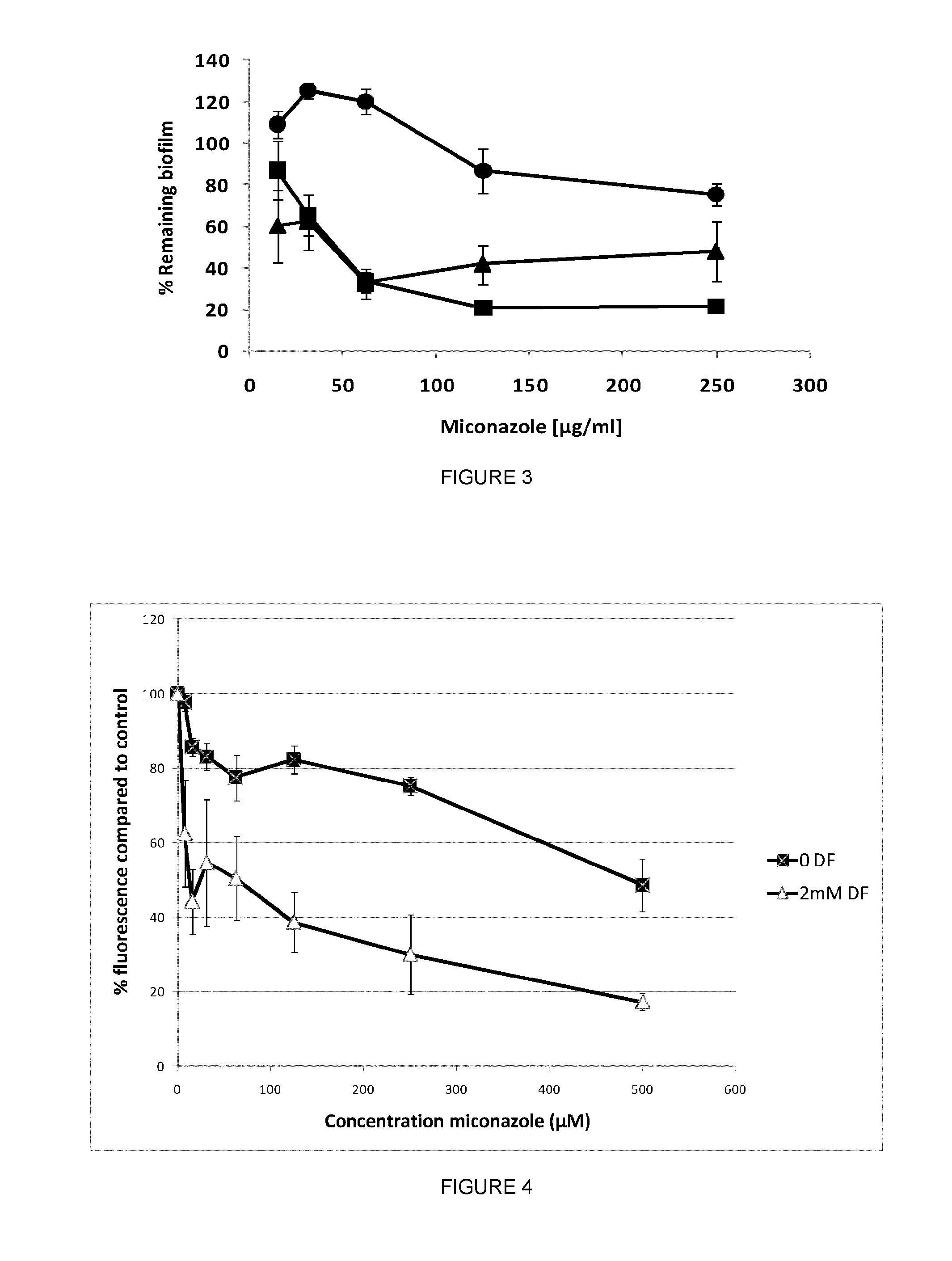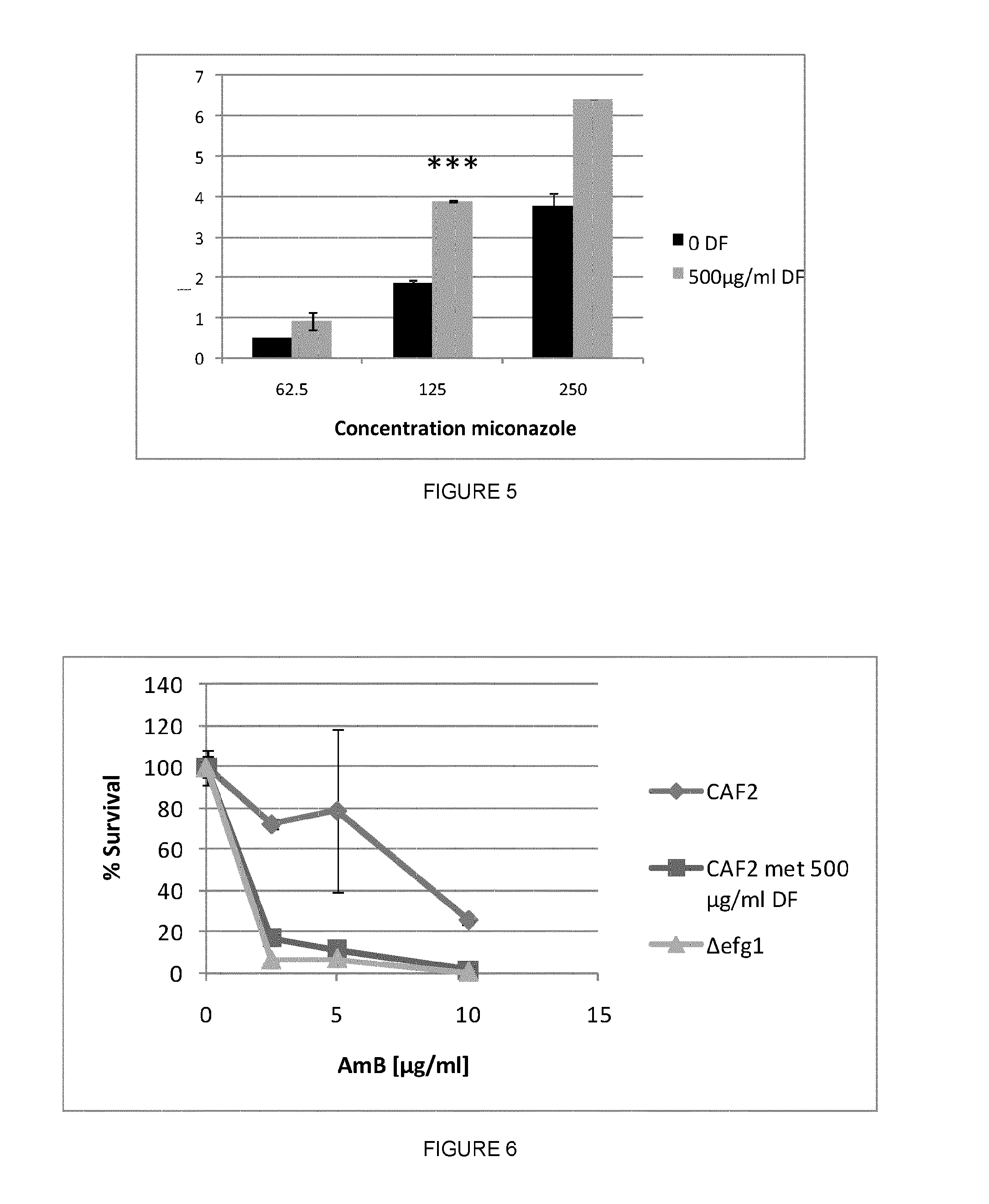Inhibition and treatment of biofilms
a biofilm and treatment technology, applied in the field of biofilm inhibition and treatment, can solve the problems of burdensome and costly revision surgery, increased patient pain, and increased susceptibility of biofilms, and achieve the effects of improving anti-biofilm properties, enhancing the efficacy of antibiotics and/or antimycotics, and increasing susceptibility and sensitivity of biofilms
- Summary
- Abstract
- Description
- Claims
- Application Information
AI Technical Summary
Benefits of technology
Problems solved by technology
Method used
Image
Examples
example 1
Efg1 Protects C. Albicans Biofilms Against Miconazole
[0205]Materials, yeast strains, plasmids and growth media. C. albicans homozygous deletion mutants used in this study are Δcdc35, Δras1, Δpde1, Δpde2 (Davis-Hanna et al. (2008) Mol. Microbiol. 67:47-62), Δefg1 (HLC52), the EFG1 reïntegrant Δefg1(EFG1) (HLC74) and the corresponding wild type CAF2. Growth medium used was YPD (1% yeast extract, 2% peptone, 2% glucose).
[0206]Biofilm activity assay. The activity of miconazole and fluconazole against 16 h-old C. albicans biofilms (107 cells / well) was assessed using the crystal violet quantification method. The biofilm-eradicating capacity of a compound was determined as the minimal concentration resulting in 50% eradication of the biofilm (BEC50).
[0207]Quantitative analysis of intracellular accumulation of miconazole in C. albicans biofilm cells. Sixteen h-old C. albicans biofilms (107 cells / well) were washed with PBS (pH 7.4) and incubated with 250 or 500 μg / ml miconazole in PBS for 4 ...
example 2
Diclofenac Increases the Sensitivity of C. Albicans WT Biofilms to Miconazole
[0217]Wild-Type C. albicans cultures were treated with 500 μg / ml diclofenac during their biofilm growth phase and the miconazole-sensitivity of the resulting biofilms was assessed.
[0218]To this end, cultures of the WT CAF2-1 were grown overnight (2×108 cells / ml) in YPD (1% yeast extract, 2% peptone, 2% glucose) and washed 3 times in PBS (pH 7.4). After dilution (OD600=0.5) in SC (1% CSM, complete amino acid supplement mixture, 1% YNB, yeast nitrogen base; 2% glucose), the cultures were resuspended (100 μl / well) in a 96well microtiter plate. After 1 h of adhesion, the adherent WT cells were incubated with or without 500 μg / ml diclofenac and allowed biofilm formation for 16 h. Next, the resulting biofilms were washed with PBS and treated with various concentrations of miconazole for 24 h in the absence or presence of diclofenac. After washing, the remaining biomass was determined using the crystal violet quan...
example 3
Intracellular Miconazole Levels are Increased in Diclofenac-Treated WT Biofilms
[0223]The intracellular accumulation of miconazole in WT biofilms grown in the prescence or absence of 500 μg / ml diclofenac upon miconazole treatment was determined to investigate whether the increased miconazole sensitivity of diclofenac-treated WT biofilms is due to an increased uptake or decreased efflux of miconazole. To this end, biofilms were grown as described above, and subsequently treated with various concentrations of miconazole in the absence or presence of diclofenac. Samples were taken for cell number determination using a Thoma counting chamber, whereafter the isolated biofilm cells were resuspended in 300 μl 70% acetonitrile / 30% PBS. Miconazole concentration in the cell lysates was determined using a HPLC setup as described previously (Bink et al. (2010) FEMS Yeast Research 10, 812-818.) and normalized to the number of cells in the pellet. Treatment of WT biofilms with 62-250 μg / ml miconaz...
PUM
| Property | Measurement | Unit |
|---|---|---|
| Pore size | aaaaa | aaaaa |
| Pore size | aaaaa | aaaaa |
| Pore size | aaaaa | aaaaa |
Abstract
Description
Claims
Application Information
 Login to View More
Login to View More - R&D
- Intellectual Property
- Life Sciences
- Materials
- Tech Scout
- Unparalleled Data Quality
- Higher Quality Content
- 60% Fewer Hallucinations
Browse by: Latest US Patents, China's latest patents, Technical Efficacy Thesaurus, Application Domain, Technology Topic, Popular Technical Reports.
© 2025 PatSnap. All rights reserved.Legal|Privacy policy|Modern Slavery Act Transparency Statement|Sitemap|About US| Contact US: help@patsnap.com



